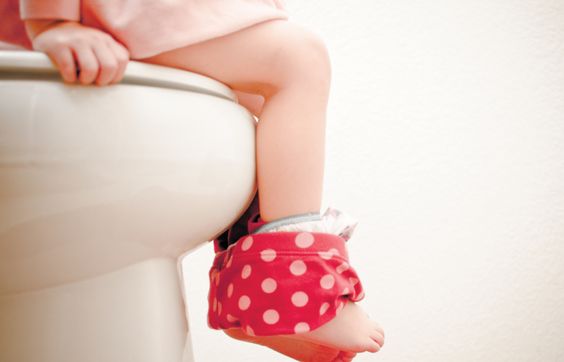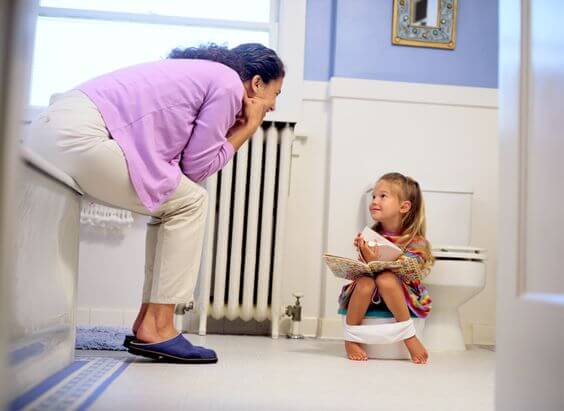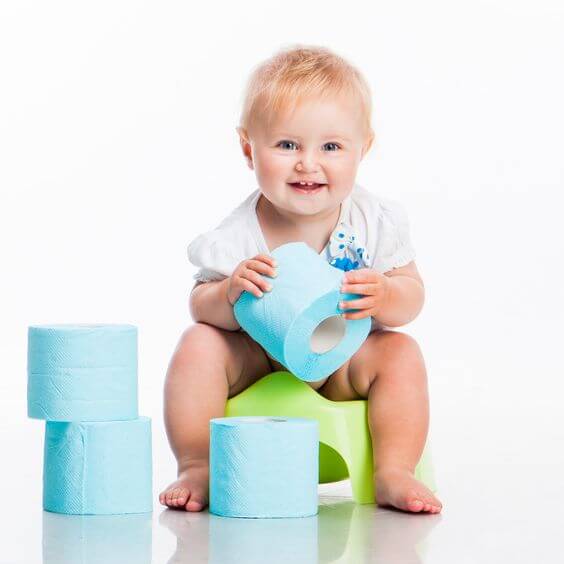Potty Training Tips from the Montessori Method

Physician and Educator Maria Montessori left us important tools for raising and educating our children. With her knowledge, she aimed to help us improve various aspects of motherhood. On this occasion, we want to talk to you about her method for potty training.
In general, children get through this process without any scars. As for us parents, the worst that can happen is that we have to do some extra cleaning up of accidents.
However, no matter what method you choose, it’s important not to pressure children. Rather, you should give them the time they need to adapt. By doing so, you will avoid possible negative psychological effects.
How to know if the Montessori method will work

The Montessori method has made major accomplishments on a worldwide level. This specialist in child development seems to have managed a high level of effectiveness in her approach. However, the outcome we achieve through her potty training method will depend on how and when we go about it.
Just the same, it’s very important that we wait for the right moment. Every child is different and learns at his own personal pace. Once a child is prepared, and so are we, the method works much better.
According to the author behind the method, it’s best to respect your little one’s personal process. Therefore, the glimpses of autonomy that your child demonstrates will serve as signals.
In his own time, your child will begin to adapt to his surroundings. Just the same, when we begin to notice a growing desire for independence, it is our duty to provide the right context so that he can reach this goal on his own.
Tips from Maria Montessori for leaving diapers behind
María Montessori’s method for potty training is based on a child’s autonomy. As parents, we sometimes become anxious and want to hurry this process. There are a variety of reasons that drive us to try to train our child to use the bathroom before he is ready.
However, Montessori, both a physician and educator, considered it very important that we be respectful of the process. In other words, we should wait patiently while at the same time offering the tools our child needs to reach the objective. Below are the main keys to this method.
Age is not the issue
Even if your child has reached an age where you think it’s time he learn to use the bathroom, that doesn’t mean he is ready. Most theories for potty training state that once a child is 2 years old, it’s time to get rid of diapers.
However, the Montessori method suggests that the right time is when the minor is physiologically capable of controlling his sphincters. A child’s age may have something to do with his maturity in this area, but it’s not the determining factor. This isn’t something your child can learn out of the blue. His body needs to be prepared.
There’s no right or wrong time of year
Sometimes we wait for a specific time of year to teach our child to abandon diapers. For example, many attempt potty training in the summer because they can wash up their children frequently and leave them in less clothing without having to worry about the cold.
Also, we may feel pressured to potty train because our children will soon be starting preschool. But just because it’s warm out and school starts in the fall, doesn’t mean your child is ready.
Provide the right environment

Montessori explained that in order to take advantage of your child’s autonomy, it’s important that your child not feel that he has to depend on others to solve his problem. Therefore, our child needs to know what he needs in order to use the bathroom, and have easy access.
If your child has a urinal, a stool, or an adapter, the items must be within his reach. That way, when he realizes he needs the bathroom, he can go on his own and easily access whatever he needs to carry out the task at hand.
Pay attention to your child’s body language
Often, parents use the technique of forcing their children to sit on the potty until they do their business. For your child, this feels like a type of punishment and is anything but motivating. It’s best not to obligate your child to sit on the toilet.
The Montessori method suggests that we pay attention to our little one’s gestures that signal it’s time to go to the bathroom. Also, we should ask frequently if he needs to poop or pee.
Avoid the reward system

The adaptation process should be natural, and your baby should see it that way. This isn’t about performing some special act, displaying a talent or carrying out a mission. We should avoid rewards because this needs to be a new step in our little one’s development.
Sooner or later, our child will acquire the level of maturity needed, and it’s important that he face this objective naturally. Furthermore, offering rewards will create a lot of pressure on your child, and lead to frustration when he doesn’t reach his goal.
Don’t reprimand or punish your child
If your child knew exactly what to do in this case, then we wouldn’t be talking about this issue. How can we expect our children to change their habits overnight when they’ve been using diapers their whole lives? Your child knows no other way of going pee and poop than to do so in his diaper.
Therefore, you need to be prepared for leaks and messes and accept them as part of the process. Don’t interpret your child’s accidents as acts of rebellion or disobedience. He’s still learning.
We need to be patient and loving, and not become angry in the face of our children’s apparent clumsiness. More than anything, we need to motivate our children to reach the objective. Try not to give any importance to accidents. Simply instruct your child without scolding or making a scandal.
Rome wasn’t built in a day
If you set out to leave diapers behind, don’t assume that you’re going to reach the goal in a specific time period. There are approaches that suggest potty training in just three days or a week. However, we all know that real life is not that precise.
Approach this method as naturally as possible; no pressure, no lofty expectations. Apply the method with the same subtlety that your little one deserves in every area. Avoid setting deadlines or time limits and you’ll see how quickly the stress goes away.
Physician and Educator Maria Montessori left us important tools for raising and educating our children. With her knowledge, she aimed to help us improve various aspects of motherhood. On this occasion, we want to talk to you about her method for potty training.
In general, children get through this process without any scars. As for us parents, the worst that can happen is that we have to do some extra cleaning up of accidents.
However, no matter what method you choose, it’s important not to pressure children. Rather, you should give them the time they need to adapt. By doing so, you will avoid possible negative psychological effects.
How to know if the Montessori method will work

The Montessori method has made major accomplishments on a worldwide level. This specialist in child development seems to have managed a high level of effectiveness in her approach. However, the outcome we achieve through her potty training method will depend on how and when we go about it.
Just the same, it’s very important that we wait for the right moment. Every child is different and learns at his own personal pace. Once a child is prepared, and so are we, the method works much better.
According to the author behind the method, it’s best to respect your little one’s personal process. Therefore, the glimpses of autonomy that your child demonstrates will serve as signals.
In his own time, your child will begin to adapt to his surroundings. Just the same, when we begin to notice a growing desire for independence, it is our duty to provide the right context so that he can reach this goal on his own.
Tips from Maria Montessori for leaving diapers behind
María Montessori’s method for potty training is based on a child’s autonomy. As parents, we sometimes become anxious and want to hurry this process. There are a variety of reasons that drive us to try to train our child to use the bathroom before he is ready.
However, Montessori, both a physician and educator, considered it very important that we be respectful of the process. In other words, we should wait patiently while at the same time offering the tools our child needs to reach the objective. Below are the main keys to this method.
Age is not the issue
Even if your child has reached an age where you think it’s time he learn to use the bathroom, that doesn’t mean he is ready. Most theories for potty training state that once a child is 2 years old, it’s time to get rid of diapers.
However, the Montessori method suggests that the right time is when the minor is physiologically capable of controlling his sphincters. A child’s age may have something to do with his maturity in this area, but it’s not the determining factor. This isn’t something your child can learn out of the blue. His body needs to be prepared.
There’s no right or wrong time of year
Sometimes we wait for a specific time of year to teach our child to abandon diapers. For example, many attempt potty training in the summer because they can wash up their children frequently and leave them in less clothing without having to worry about the cold.
Also, we may feel pressured to potty train because our children will soon be starting preschool. But just because it’s warm out and school starts in the fall, doesn’t mean your child is ready.
Provide the right environment

Montessori explained that in order to take advantage of your child’s autonomy, it’s important that your child not feel that he has to depend on others to solve his problem. Therefore, our child needs to know what he needs in order to use the bathroom, and have easy access.
If your child has a urinal, a stool, or an adapter, the items must be within his reach. That way, when he realizes he needs the bathroom, he can go on his own and easily access whatever he needs to carry out the task at hand.
Pay attention to your child’s body language
Often, parents use the technique of forcing their children to sit on the potty until they do their business. For your child, this feels like a type of punishment and is anything but motivating. It’s best not to obligate your child to sit on the toilet.
The Montessori method suggests that we pay attention to our little one’s gestures that signal it’s time to go to the bathroom. Also, we should ask frequently if he needs to poop or pee.
Avoid the reward system

The adaptation process should be natural, and your baby should see it that way. This isn’t about performing some special act, displaying a talent or carrying out a mission. We should avoid rewards because this needs to be a new step in our little one’s development.
Sooner or later, our child will acquire the level of maturity needed, and it’s important that he face this objective naturally. Furthermore, offering rewards will create a lot of pressure on your child, and lead to frustration when he doesn’t reach his goal.
Don’t reprimand or punish your child
If your child knew exactly what to do in this case, then we wouldn’t be talking about this issue. How can we expect our children to change their habits overnight when they’ve been using diapers their whole lives? Your child knows no other way of going pee and poop than to do so in his diaper.
Therefore, you need to be prepared for leaks and messes and accept them as part of the process. Don’t interpret your child’s accidents as acts of rebellion or disobedience. He’s still learning.
We need to be patient and loving, and not become angry in the face of our children’s apparent clumsiness. More than anything, we need to motivate our children to reach the objective. Try not to give any importance to accidents. Simply instruct your child without scolding or making a scandal.
Rome wasn’t built in a day
If you set out to leave diapers behind, don’t assume that you’re going to reach the goal in a specific time period. There are approaches that suggest potty training in just three days or a week. However, we all know that real life is not that precise.
Approach this method as naturally as possible; no pressure, no lofty expectations. Apply the method with the same subtlety that your little one deserves in every area. Avoid setting deadlines or time limits and you’ll see how quickly the stress goes away.
All cited sources were thoroughly reviewed by our team to ensure their quality, reliability, currency, and validity. The bibliography of this article was considered reliable and of academic or scientific accuracy.
- Campos, O., & Claudia, R. (2003). Método Montessori. Psicopedagogía II Semestre.
- Febres-Cordero Intriago, I. M. (2014). La importancia de promover la autonomía en niños de cero a cinco años(Bachelor’s thesis, Quito, 2014). http://repositorio.usfq.edu.ec/handle/23000/3152
- Hainstock, E. (2013). Teaching Montessori in the home: The Pre-School years.Toronto: Random House.
- Montessori, M. (2013). Metode Montessori. Jogjakarta: Pustaka Pelajar.
- Pitamic, M. (2004). Teach me to do it myself: Montessori activities for you and your child. New York: Barron ́s Educational Series, Inc.
- Seldin, T. & Epstein, P. (2003). The Montessori way. Florida: Todd Allen Printing Co.Inc.
- Valdebenito, P. E., Profesora, V., Claudia, I. :, Bocaz, S., Campos, R., Ramo, O., & Loyola, : (2003). METODO MARIA MONTESSORI. Instituto Profesional Luis Galdames.
This text is provided for informational purposes only and does not replace consultation with a professional. If in doubt, consult your specialist.








